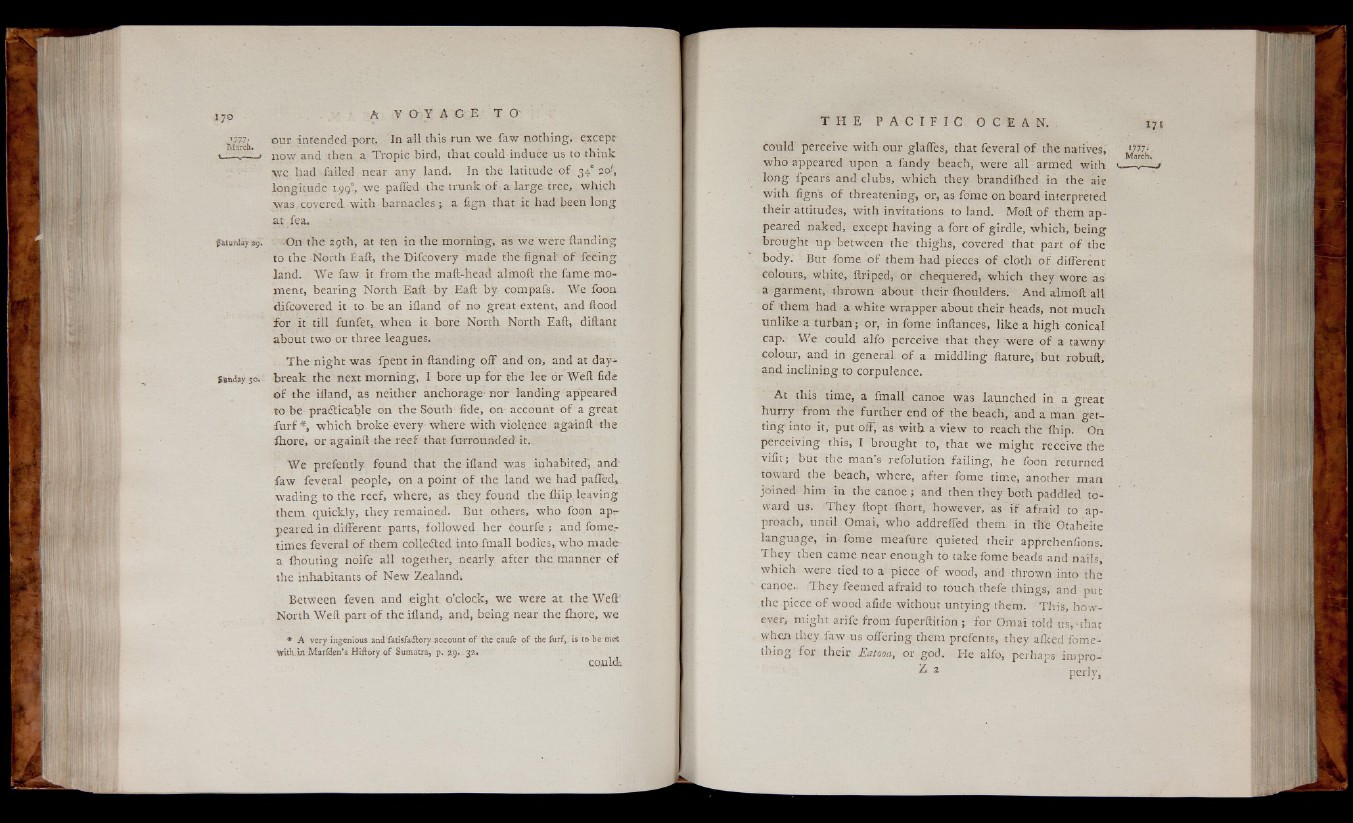
3®f
March.
$àturdày 29.
Sunday 30.
our intended port. In all this run we faw nothing, except
now and then a Tropic bird, that could induce us to think
we had failed near any land. In the latitude of 34° 2?<,
longitude 1.99!, we palled the trunk of a large tree, which
was covered with barnacles | a fign that it had been long
at fea.
On the 29th, at ten in the morning, as we were Handing
to the North Eaft, the Difcovery made the fignal of feeing
land. We faw it from the maft-head almoft the fame moment,
bearing North Eaft by Eaft by compafs. We foon
difcovered it to be an ifland of no great extent, and flood
for it till funfet, when it bore North North Eaft, diftant
about two or three leagues.
The night was fpent in ftanding off and on, and at daybreak
the next morning, I bore up for the lee or Weft fide
of the ifland, as neither anchorage nor landing appeared
to be practicable on the South fide, on account of a great
furf *, which broke every where with violence againft the
ihore, or againft the reef that furrounded'- it..
We prefently found that the ifland was inhabited, and:
faw feveral people, on a point of the land we had palled,
wading to the reef, where, as they found the IHip leaving
them quickly, they remained. But others, who foon appeared
in different parts, followed her courfe ; and fome-
times feveral of them collected into Email bodies, who made
a fhouting noife all together, nearly after the,manner of
the inhabitants of New Zealand,
Between feven and eight o’clock, we were at the Weft'
North Weft part of the ifland, and, being near the ihore, we
* A very ingenious and ‘fatisfa&ory- account o f the caufe o f the furf,, is to be met
with, in Marfden’s Hiftory of Sumatra, p. 29... 32»
could.
could perceive with our glaffes, that feveral o f the natives,
who appeared upon a fandy beach, were all armed with
long fpears and clubs, which they brandifhed in the air
with ligns of threatening, or, as fome on board interpreted
their attitudes, with invitations to land. Moil of them appeared
naked, except having a fort of girdle, which, being
brought up between the thighs, covered that part of the
body. But fome of them had pieces of cloth of different
colours, white, ftriped, or chequered, which they wore as
a garment, thrown about their ftioulders. And almoft all
of them had a white wrapper about their heads, not much
unlike a turban; or, in fome inftances, like a high conical
cap. We could alfo perceive that they were of a tawny
colour, and in general of a middling ftature, but robuft,
and inclining to corpulence.
At this time, a fmall canoe was launched in a great
hurry from the further end of the beach, and a man getting
into it, put off, as with a view to reach the ihip. On
perceiving this, I brought to, that we might receive the
vilit; but the man’s refolution failing, he foon returned
toward the beach, where, after fome time, another man
joined him in the canoe ; and then they both paddled toward
us. They ftopt ihort, however, as if afraid to approach,
until Omai, who addreffed them in the Otaheite
language, in fome meafure quieted their apprehenfions.
They then came near enough to take fome beads and nails,
which were tied to a piece o f wood, and thrown into the
canoe. They feemed afraid to touch, thefe things, and put
the piece of wood afide without untying them. This, however,
might arife from fuperftition ; for Omai told us,-that
when they faw us offering them prefents, they allied fome-
thing for their Eatooa, or god. He alfo, perhaps iropro-
^ 2 perly,